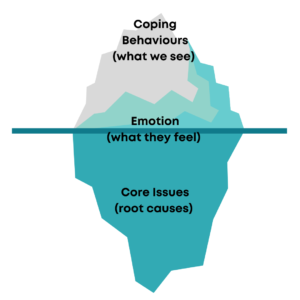The importance of looking beneath the iceberg
We frequently discuss that behaviour can be likened an iceberg. However, from my experiences as both a teacher and a therapist, this can unintentionally be forgotten when it comes to managing and responding to children’s behaviour.
The iceberg analogy gives us an opportunity to consider all the contributing factors which may be affecting a child’s behaviour and responses to situations. It encourages us to have more empathy and compassion with a situation that a child is navigating.
Behaviour is a response to feelings.
Feeling come from an inner need in the child which need to be fulfilled.
So, what contributes to a child’s reactions?
Children’s responses to situations can be influenced by the environment that they have both been raised in, and their daily routines and experiences. This can include:
- Their life experiences
- Their knowledge
- Their skills
- Their self-worth
- Their self-image and sense of self
- Their feelings of safety
- Their emotional literacy
- Their resilience
- Family dynamics
- Sleep quality and quantity
- Nutrition
- Hydration
- Temperature
- Past experiences, including abuse, neglect, abandonment
If a child has experienced high levels of stress or adversity in their childhood, their learnt experiences and reactions to situations may be different to a child who has grown up with a sense of safety and security. This influences the coping behaviours that children develop to cope with difficult emotions.
What happens?

The iceberg has three layers:
- Coping behaviours – what we see happen
- Emotion – what is being felt
- Core issues – the root cause
Coping Behaviours
Coping behaviours are the way that a child responds to stress/fear or threat. This might include: yelling, shouting, hitting, kicking, hiding, lying, eating, stealing, running, swearing, self-harming, tic behaviours, hair pulling, nail biting…..
At some point, these coping behaviours were useful to a child, they would have worked in some situations and have been stored as a useful response, even if they are no longer helping them. Coping behaviours all aim, on some level, to develop a reaction, which derives attention and therefore connection. Children, fundamentally, want to be protected, and drawing people to them, even if it is through negative feedback, fulfils this need, even if it is to a maladaptive reaction.
Even if a child is now in a situation where they have access to healthier responses, they will require support to change the patterns of behaviours that they have learnt.
Emotion
Emotions are the automatic response that the child feels in response to the triggering event. The trigger comes from a root cause being affected in some way, to which the child emotionally responds. These can be a feeling of threat, of negative feedback, of overwhelm, stress or sensory overload which the child responds with their coping behaviour.
It is important to remember, that our reactions to things do not remain fixed. Triggers can get bigger and smaller, and may attach to other issues which affect the child. In addition, in some situations a child’s coping behaviour may not be triggered, such as if they felt particularly safe or were in a predictable environment, whilst in others they may react more quickly or severely.
It should be noted, that the way we react and respond to a child who is being triggered can also have a dramatic impact on whether a coping behaviour is activated. If our responses activates their ‘threat’ mode then this can accelerate the reactions.
Core Issues
The core issues are the root causes of the challenges that a child is experiencing. These root causes develop core beliefs which affect a child’s emotions and coping behaviours. For instance, a child who has been through abuse and neglect, may be fearful of developing strong attachments as they are scared of being hurt again, fearful of being rejected, fearful of being abandoned, fearful of being attacked.
These issues often have strong ties to sensations of shame, guilt, fear, grief and pain. Some of the strongest emotions experienced by children. This can be associated with a sense that they are to blame or responsible for what has happened to them, and drives the feelings and coping behaviours that they experience.
Consider, the child who was abandoned by their family may find it incredibly challenging to manage being the last to be picked for a team game, in comparison to a child who grew up feeling secure. What may be deemed as an overreaction by some adults, is a response to a trigger of feeling rejected. Or, think about the child who was subjected to verbal abuse at home who finds being highlighted for not doing their homework in front of the class exceptionally challenging. Sometimes, our behaviours may look, from the outside as unacceptable, but have a very significant reason for their existence.
Parting thoughts
Whilst behaviour can be incredibly challenging to respond to in a nurturing way. Taking the time and opportunities to have compassion and empathy for a child’s individual icebergs can support us to better consider our strategies and management at home and in the classroom as well as identify the therapeutic support that children require.
© Dandelion Training and Development – All Rights Reserved
Further help
 For more articles about mental health visit – ARTICLES
For more articles about mental health visit – ARTICLES
To learn more about child and adolescent mental health visit – COURSES
For resources to support child and adolescent mental health visit –RESOURCES
